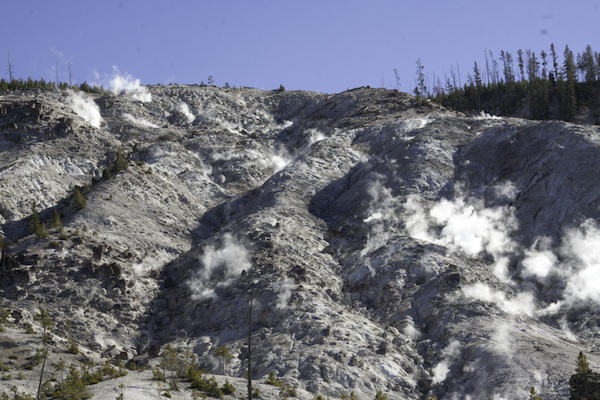THROUGH THE MIST
Chamber music for winds and strings by Pamela J. Marshall
Ravello
Records
About Through the Mist Communing with Birds Zoa Dance of the Hoodoos Examinate Variations Waves and Fountains Bios Credits

Zoa
duo for flutes and harp
Inspiration
Zoa for multiple flutes and harp is dedicated to the Duo “2”, who gave the world premiere in 2011 in Boston on the Advent Library Concert Series. The members of "2" - Peter H. Bloom on flutes and Mary Jane Rupert on harp - inspired me to reach deeply into their rich sound palette, and they didn't flinch from the experimentation I asked of them.
The sounds in Zoa are an imagined music of elemental creatures. I pictured "protozoa," as well as William Blake's monumentally mystic poem "The Four Zoas," where each Zoa is both a force of nature and an aspect of our personas. The score uses the otherworldly sounds of extended techniques to represent the primordial environment. “2” grabbed onto my concept and experimented with the effects to make the music flow.
Techniques
The harpist scrapes and brushes strings on her way to both wild and gentle glissandi and angular rhythms; the flutist (playing alto flute, C flute, and piccolo), begins with thumps and clicks, out of which the wind-filled gentle voice of the alto flute emerges. Both primordial and joyful, the flute breaks into leaping song and tremolando exchanges with the harp. In a middle section, the piccolo and harp dance together playing invented scales. Wispy tenuous notes of the pianissimo piccolo and a halting, repeating motive in the harp end the piece.
Images
The geysers, vents and steaming landscape of Yellowstone National Park seem an appropriate image for Zoa. The image at the top is Roaring Mountain in Yellowstone. Photo by David Emerson, Honeycreeper Images.
Peter Bloom's Performance Notes
Though it’s not “program music,” Zoa has programmatic elements that are vividly evocative on many levels: micro/macro, biological/cosmological, physical/metaphysical, and concrete/abstract. With these many dialectical elements in play, the work quickly captures the performers’ imaginations and the audiences’ attention.
We’ve performed Zoa on programs dedicated to new (21st century works) as well as at more general concerts of music from the 18th century onward. The piece is always enthusiastically received – positive proof that the piece is “audience friendly” even though its sonic diversity challenges the listener. This, I’m certain, is the result of the composer knowing precisely what she wants to hear and collaborating sensitively, with performers, in order to achieve it.
Writing well for concert harp is an enormous challenge for any composer. Composing and orchestrating effectively for harp with alto flute (doubling concert flute and piccolo) requires both patience and a willingness to yield to the results of collaborative experimentation. Pam’s practice of making sure that she notates precisely what’s in her mind’s ear supports her patient exactitude.
The depth of Zoa’s musical palette, however, also includes a regular dose of sonic goofiness wherein the music’s primordial creatures and mystical spirits don metaphorical aural tutus and bounce around in an imaginary pas-des-deux.
Among the most enthusiastic receptions Zoa has received, was at a performance of all 21st century music at Lipscomb University in Nashville TN. The concert was held in a surprisingly good acoustical space that was designed to double as a concert hall and science lab/theatre. Pam, as a visiting artist, lectured on the music before the performance. The audience was transfixed and transported. How perfectly appropriate!
by Peter H. Bloom
Sheet Music - Zoa for flute & harp
